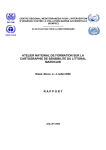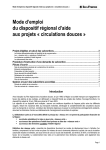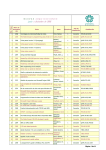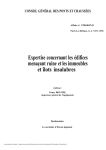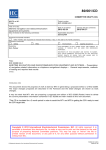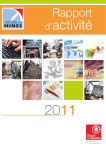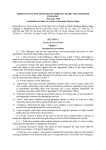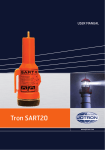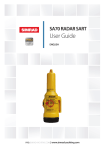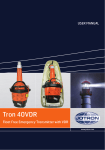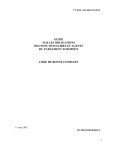Download L`OMI EN 50 L E ç ON s
Transcript
L’OMI EN 50 Leçons www.armateursdefrance.org 1 N°1 www.armateursdefrance.org Une ONU de la Mer ? L’idée est bonne. Si bonne que déjà, en 1948, une convention de l’ONU signée à Genève portait création d’une Organisation Internationale onusienne de la Mer : l’OMI. à quoi sert l’OMI ? Qui y siège ? Comment est-elle organisée ? Comment y sont élaborées les conventions internationales ? Qui y décide ? Qui a le pouvoir ? Quelle place la France y occupe-t-elle ? Elle s’est réunie pour la première fois en 1959 et a permis la signature de plus de 70 conventions en 50 ans. Quelles sont les grandes conventions de l’OMI ? Ces textes internationaux s’imposent-ils aux états ? Comment l’OMI veille-t-elle au respect des réglementations par les états ? L’OMI peut-elle sanctionner les « contrevenants » ? Qu’est-ce que le FIPOL ? Est-ce le peu d’intérêt de notre pays pour l’international en général, pour la mer en particulier ? En tout état de cause, l’OMI est à l’évidence très méconnue ; elle est pourtant le seul lieu pertinent pour l’élaboration de la réglementation maritime : la mer est sans frontières. L’ONU de la Mer existe. Avec ce livret, Armateurs de France vous invite à découvrir cette institution « phare ». Anne Sophie AVÉ Délégué général d’Armateurs de France L’OMI EN 50 Leçons à l’OMI, les conventions s’élaborent dans le consensus international, par les contributions et les travaux de ses membres. L’influence des états sur les textes et les décisions n’est pas fonction de leur poids économique mais de l’assiduité et de la qualité des apports techniques de leurs représentants. Around THE IMO IN 50 LESSONS L’OMI EN 50 Leçons Around THE IMO IN 50 LESSONS L’ONU de la mer : l’Organisation Maritime Internationale (OMI) The body convened in 1959 for the first time and has since helped sign 70 conventions in the span of 50 years. Is it due to France’s general lack of interest for international matters or is it just because it is the sea? In any event, IMO is clearly not well known over here, and yet it is the only relevant forum to work on maritime regulations, for the sea has no borders. At IMO, conventions are prepared within an international consensus through the respective contributions and work of its members. The What is the purpose of IMO? Who can be a member? How is it organised? How are international conventions developed? Who makes the decisions? Who has the power? What is the place of France? What are the IMO’s major conventions? Are these international regulations binding for States? How can IMO see to it that States abide by these regulations? Can IMO sanction offenders? What is IOPCF? The UN of the Sea now exists. With this booklet, Armateurs de France invites you to discover this leading institution. Anne Sophie AVÉ Director General of Armateurs de France L’OMI EN 50 Leçons United Nations of the Sea? The idea sounds good. So good that as early as 1948, a UN convention signed in Geneva established a UN International Maritime Organisation: IMO. influence of States on the text of laws and decisions made does not depend on their respective economic leverage but more on their consistent involvement and the quality of their representatives’ technical input. Around THE IMO IN 50 LESSONS L’OMI EN 50 Leçons Around THE IMO IN 50 LESSONS United Nations of the Sea: the International Maritime Organisation (IMO) 90 % du commerce mondial est transporté par mer. Dès 1948, l’ONU s’est dotée d’une agence spécialisée pour les questions maritimes : l’Organisation Maritime Internationale. Son rôle est d’élaborer et de mettre en œuvre des réglementations maritimes communes à tous les États membres. L’OMI EN 50 Leçons QU’EST-CE QUE L’OMI ? WHAT IS IMO? 90% of the world trade is conveyed by sea. As early as 1948, the UN set up a dedicated agency for shipping matters: the International Maritime Organisation. Its purpose is to devise and implement maritime regulations shared by all member states. Around THE IMO IN 50 LESSONS 1 La dimension internationale des questions maritimes ne date pas de la création de l’OMI. Dès le XVIIIe siècle, les États ont été contraints de conclure des accords bilatéraux ou multilatéraux. C’est le cas, en 1713, date du Traité d’UTRECHT contenant, parmi d’autres, des dispositions sur la pêche. Plus récemment, en 1914, les premiers travaux relatifs à la Convention sur la sauvegarde de la vie humaine en mer (SOLAS) ont été initiés. À l’origine, à défaut d’une coopération suffisante entre les États, de nombreux litiges étaient portés devant la Cour internationale de justice. Cette « ONU de la mer » a permis d’harmoniser le droit et de désengorger la Cour. Around THE IMO IN 50 LESSONS 2 L’OMI EN 50 Leçons L’ÉTAT DU DROIT AVANT L’OMI Dès la création de l’OMI, les États, conscients du caractère international du transport maritime, ont décidé de renoncer aux mesures unilatérales pour privilégier un encadrement à l’échelle mondiale. Il s’agissait également d’éviter les comportements protectionnistes qui entravent l’expansion de la navigation. L’OMI a ainsi permis une meilleure coopération entre les États et une harmonisation vers le haut des normes. 3 WHY IMO IS NECESSARY? THE STATE OF LAW PRIOR TO IMO Since IMO was established, member states, as they became increasingly aware of the international nature of maritime transport, decided to turn their back on unilateral measures to the benefit of a worldwide supervision approach. The idea was also to prevent those protectionist behaviours that stifle the development of navigation; IMO was thus able to promote stronger cooperation between states and concord standards and practices. The international dimension of maritime matters didn’t come about with the establishment of IMO. As early as the 18th century, States were obliged to enter into bilateral or multilateral agreements. Such was the case in 1713, with the UTRECHT Treaty which, laid out a number of provisions on fishing. More recently, in 1914, the first steps were initiated to lay the grounds for the International Convention for the Safety of Life at Sea (SOLAS). Short of adequate inter-State cooperation mechanisms, many disputes heretofore been taken to the International Court of Justice. This “United Nations of the Sea” thus made it possible to standardise the law and relieve the burden on the Court. Around THE IMO IN 50 LESSONS L’OMI EN 50 Leçons POURQUOI L’OMI ? Faux. Le texte international fondant l’OMI est la Convention portant création de l’Organisation Maritime Internationale signée en 1948 à Genève, et non la Convention des Nations Unies sur le droit de la mer dite « Convention de Montego Bay » (1982). La Convention fondatrice est entrée en vigueur en 1958, dix années au cours desquelles le rôle de l’OMI a été étendu aux enjeux environnementaux, à la question de la formation des gens de mer et aux problèmes d’ordre juridique. Around THE IMO IN 50 LESSONS 4 L’OMI EN 50 Leçons Vrai. Jusqu’au 22 mai 1982, l’Organisation portait le nom d’Organisation Maritime Consultative Internationale. L’OMCI est donc officiellement le premier organisme international chargé des questions exclusivement maritimes. Substantiellement, il n’existe toutefois aucune différence entre l’OMCI et l’OMI. VRAI/FAUX LA CONVENTION DE MONTEGO BAY FONDE L’OMI 5 RIGHT OR WRONG IMCO PRECEDED IMO Right. Up until 22 May 1982, the Organisation was known as Inter-Governmental Maritime Consultative Organization, or IMCO. The IMCO was therefore the first international body exclusively in charge of maritime affairs. In actual fact, there is no difference between IMCO and IMO. RIGHT OR WRONG THE MONTEGO CONVENTION ESTABLISHED IMO Wrong. The international agreement that created IMO was the Convention establishing the International Maritime Organisation signed in 1948 in Geneva and not the United Nations’ Convention on maritime law known as “Convention of Montego Bay” (1982). The founding Convention became effective in 1958 after ten years during which the role of IMO was extended to embrace environmental issues, seafarers’ training and legal matters. Around THE IMO IN 50 LESSONS L’OMI EN 50 Leçons VRAI/FAUX L’OMCI A PRÉCÉDÉ L’OMI Environ 300 personnes travaillent à temps plein à l’OMI auprès du Secrétariat général. Comparé à d’autres organisations internationales, c’est un effectif relativement limité (ex. : l’OMC compte près de 700 personnes). Le personnel permanent, à la différence des représentants des États membres, ne prend aucune décision sur le fond ; son rôle est de faciliter le travail des États et de promouvoir l’Organisation à l’échelle internationale. Around THE IMO IN 50 LESSONS 6 L’OMI EN 50 Leçons QUI TRAVAILLE À L’OMI ? Le siège de l’OMI est à Londres, au 4 Albert Embankment. Elle est la seule agence spécialisée des Nations Unies installée au Royaume-Uni pour des raisons historiques : le Royaume-Uni a toujours joué un rôle fondamental dans le monde maritime international. Le bâtiment de l’OMI a été rénové en 2008 : les nouveaux locaux offrent, depuis la terrasse du restaurant, une vue imprenable sur Londres, la Tamise et l’Abbaye de Westminster. 7 LONDON AND IMO: A LOVE STORY! WHO WORKS AT IMO? IMO has its headquarters in London at 4 Albert Embankment. It is the only dedicated agency of the UN that is based in the UK, and the reason is to be found in history: the United Kingdom has always played a central role in shipping. The IMO building was revamped in 2008: from their restaurant’s terrace, the new premises offer an unbeatable view on London, river Thames and Westminster Abbey. IMO boasts some 300 full-time employees working under the SecretaryGeneral. This figure is quite small compared with other international organisations (e.g.: WTO has 700). Unlike the representatives of member states, the full-time staff does not have any decision-making power on the basic issues; their role is to facilitate the work of States and promote the Organisation on the international stage. Around THE IMO IN 50 LESSONS L’OMI EN 50 Leçons LONDRES ET L’OMI : UNE HISTOIRE DE CŒUR ! L’OMI est constituée de 168 États membres et de 3 États membres associés (Hong Kong-Chine, Macao-Chine, et les Îles Féroé-Danemark). Ces derniers ne peuvent pas prendre part au vote du Conseil. Beaucoup d’États sont membres depuis la création de l’OMI. C’est le cas du Royaume-Uni, présent depuis 1949. La France a rejoint l’Organisation en 1952. L’OMI accueille de nouveaux États chaque année (Îles Cook en 2008). Around THE IMO IN 50 LESSONS 8 L’OMI EN 50 Leçons LES ÉTATS MEMBRES Les États membres contribuent annuellement au budget de l’OMI. Les contributions sont calculées sur la base du tonnage de la flotte marchande de chaque État. Ainsi, les plus gros contributeurs sont les États qui disposent des capacités effectives de transport de marchandises par mer les plus importantes. En 2009, le budget de l’OMI s’élevait à £ 27 870 0 00. Toutefois, le montant des cotisations n’impacte pas les droits de vote. Chaque pays dispose d’une voix. Il est donc primordial pour les États de déléguer des représentants assidus et actifs. 9 IMO’S BUDGET MEMBER STATES Members States contribute to the annual IMO’s budget. This contribution is based on the tonnage of each State’s merchant fleet. The highest contributors are therefore those States with the largest actual shipping capacity. In 2009, IMO’s budget stood at £ 27 870 000. The level of contributions does not, however, affect voting rights as all governments participate on an equal footing. It is therefore crucial that States appoint devoted representatives. IMO is composed by 168 Member States and 3 associate members (Hong Kong-China, Macao-China, and the Faeroe Islands-Denmark). The latter three are not entitled to take part in the votes of the Council. Many States have been members ever since the inception of IMO such as the United Kingdom who joined the organisation in 1949, and France a few years later in 1952. IMO welcomes new members every year (Cook Islands in 2008). Around THE IMO IN 50 LESSONS L’OMI EN 50 Leçons LE BUDGET DE L’OMI Les organisations non gouvernementales ayant la capacité d’apporter une véritable contribution au travail de l’OMI peuvent se voir attribuer un statut consultatif par le Conseil, après approbation de l’Assemblée. C’est le cas de l’International Chamber of Shipping (association internationale des armateurs) et de Greenpeace. Elles sont une quarantaine et ont un rôle d’observateur. L’OMI peut également conclure des accords de coordination avec des organisations intergouvernementales en fonction des sujets (une trentaine à ce jour). Chaque État membre nomme des représentants à l’OMI pour participer aux débats et travaux des comités ou des sous-comités. Il peut s’agir de représentants permanents en titre, souvent ambassadeurs, et de délégations ponctuelles. Les observateurs, quant à eux, s’ils peuvent assister les travaux des représentants, n’ont aucun pouvoir décisionnel. Around THE IMO IN 50 LESSONS 10 L’OMI EN 50 Leçons REPRÉSENTANTS DES ÉTATS ET OBSERVATEURS : QUELLE DIFFÉRENCE ? 11 NON-GOVERNMENTAL AND INTER-GOVERNMENTAL ORGANISATIONS STATE REPRESENTATIVES AND OBSERVERS: WHAT’S THE DIFFERENCE? Non-governmental organisations that have the capability to genuinely contribute to IMO’s work can be granted a consultative status by the Council, subject to approval by the Assembly. For instance, this has been the case for the International Chamber of Shipping and Greenpeace. In all, there are some forty NGO acting as observers. IMO may also from time to time enter into coordination agreements with intergovernmental organisations as appropriate (thirty to this day). Each Member State appoints representatives to IMO to take part in the proceedings and work of the various committees and sub-committees. These may be permanent official representatives such as ambassadors and punctual delegations. The observers, although they may assist in the work of representatives, take no part in the decision-making process. Around THE IMO IN 50 LESSONS L’OMI EN 50 Leçons ORGANISATIONS NON GOUVERNEMENTALES ET INTERGOUVERNEMENTALES et le septième Secrétaire général de l’OMI. Son premier mandat de quatre ans a été renouvelé le 9 novembre 2006 jusqu’au 31 décembre 2011. Parmi ses six prédécesseurs, l’un était français : M. Jean ROULLIER fut Secrétaire général de 1964 à 1967. La mission principale du Secrétaire général de l’OMI est de soutenir et de développer la crédibilité de l’Organisation. Il est nommé par le Conseil avec l’approbation de l’Assemblée. Oui. Depuis septembre 2001, le mémorial international des marins du monde est exposé devant le siège de l’OMI. Il représente un marin solitaire à la proue d’un navire de commerce. Cette œuvre, du sculpteur Michael SANDLE, est dédiée aux gens de mer. Sa configuration théâtrale a transformé la façade du bâtiment de l’OMI, qui est ainsi devenue un véritable point de repère dans Londres. Around THE IMO IN 50 LESSONS 12 13 RIGHT OR WRONG IMO IS HEADED BY A FRENCHMAN Wrong. Mr. Efthimios MITROPOULOS, a Greek citizen, is the acting (and seventh) Secretary-General of IMO. His first 4-year mandate was renewed on 9 November 2006 until 31 December 2011. Among the 6 people who paved the way for him in this function there was indeed a French national: Mr. Jean ROULLIER, who acted as Secretary-General from 1964 to 1967. The IMO Secretary-General’s main mission is to promote and reinforce the Organisation’s credibility. He is appointed by the Council and endorsed by the Assembly. IS THE IMO SEAFARER, A SOLITARY MAN? Yes. Since September 2001, the international memorial to the world’s seafarers is exposed in front of the IMO headquarters. It represents a lone seafarer at the bow of a merchant ship. This work of art, by sculptor Michael SANDLE, is dedicated to all seafarers. Its dramatic design and massive scale have totally transformed the façade of the IMO building which has thus become a real landmark in London. Around THE IMO IN 50 LESSONS L’OMI EN 50 Leçons Faux. M. Efthimios MITROPOULOS, de nationalité grecque, est l’actuel LE MARIN DE L’OMI EST-IL SOLITAIRE ? L’OMI EN 50 Leçons VRAI/FAUX L’OMI EST DIRIGÉE PAR UN FRANÇAIS L’OMI est composée d’une Assemblée, d’un Conseil et de comités, eux-mêmes parfois constitués de sous-comités. L’Assemblée est l’organe directeur de l’OMI. Elle se réunit une fois tous les deux ans. Le reste du temps, c’est le Conseil qui joue ce rôle. Il existe cinq comités permanents dont ceux de la « Sécurité maritime » et de la « Protection du milieu marin », les plus importants. Viennent ensuite les Comités de la « Coopération technique », « Juridique » et de la « Simplification des formalités ». Around THE IMO IN 50 LESSONS 14 L’OMI EN 50 Leçons COMMENT EST ORGANISÉE L’OMI ? Tous les ans, l’OMI célèbre la journée mondiale de la mer. Celle-ci a traditionnellement lieu la dernière semaine de septembre. Son objectif est de promouvoir les questions de sécurité, de sûreté ou d’environnement maritimes auprès du grand public. 15 THE WORLD MARITIME DAY HOW IS IMO ORGANISED? Every year, IMO celebrates the “World Maritime Day”, traditionally held on the last week of September. Its aim is to highlight issues of maritime safety, security or environment for the public at large. IMO is constituted by Assembly, a Council and committees, sometimes also sitting in the form of sub-committees. The Assembly is the governing body of IMO, it convenes every two years. The rest of the time the Council acts as the leading body. There are 5 standing committees, most important of which are “Maritime safety” and “Marine Environment Protection”. Next are the “Legal”, “Technical Co-operation” and “Facilitation” committees. Around THE IMO IN 50 LESSONS L’OMI EN 50 Leçons LA JOURNÉE MONDIALE DE LA MER Le Comité « Protection du milieu marin » (MEPC), chargé de la prévention et de la lutte contre les pollutions, est constitué de tous les États membres. Il est le premier organe subsidiaire de l’Assemblée à avoir été créé, ce qui traduit une préoccupation majeure de l’OMI pour les questions environnementales. Il est compétent pour amender les conventions relatives aux enjeux environnementaux, telles que MARPOL (MARine POLlution Convention). Around THE IMO IN 50 LESSONS 16 L’OMI EN 50 Leçons UN COMITÉ POUR LA PROTECTION DU MILIEU MARIN Le Comité « Sécurité maritime » (MSC) est l’organe technique le plus important de l’OMI. Tous les États membres y ont un représentant. Le MSC réglemente les enjeux internationaux relatifs à la navigation, la construction et l’équipement des navires, la prévention des collisions, la manutention des marchandises dangereuses et tout autre sujet relatif à la sécurité en mer. Le Comité adopte les amendements à des conventions majeures, telles que SOLAS (Safety of Life at Sea). Il peut aussi soumettre des recommandations à l’Assemblée. 17 A COMMITTEE FOR MARITIME SAFETY A COMMITTEE FOR THE MARINE ENVIRONMENT PROTECTION The MSC or “Maritime Safety Committee” is IMO’s senior technical body and every member State has a representative sitting on this committee. The MSC works on the various maritime issues related to navigation, shipbuilding and fitting, collision prevention, handling of hazardous goods and any other matters related to safety at sea. The Committee adopts amendments to major conventions such as SOLAS (Safety of Life at Sea) and it may also from time to time submit recommendations to the Assembly. The MEPC or “Marine Environment Protection Committee”, in charge of preventing all types of sea pollution, also involves all member States. It was the first subsidiary organ of the Assembly to be established, which reflects IMO’s level of concern for these environmental issues. It has the competence to amend any conventions relating to environmental issues, such as MARPOL (MARine POLlution Convention). Around THE IMO IN 50 LESSONS L’OMI EN 50 Leçons UN COMITÉ POUR LA SÉCURITÉ MARITIME Le Comité « Coopération technique » (TCC) est chargé de coordonner les activités d’assistance technique fournies par l’OMI. Il accompagne tout particulièrement les pays émergents dans la mise en œuvre de la réglementation OMI. Première organisation à avoir reconnu officiellement un organe de ce type dans son acte constitutif, l’OMI tend à harmoniser progressivement le droit maritime international. Around THE IMO IN 50 LESSONS 18 L’OMI EN 50 Leçons UN COMITÉ POUR LA COOPÉRATION TECHNIQUE Le Comité « Juridique » (LEG) a été constitué, à l’origine, pour traiter les problèmes juridiques posés par l’accident du Torrey Canyon (1967). Il est devenu ensuite comité permanent, chargé d’examiner toutes les questions juridiques qui relèvent de la compétence de l’Organisation. Même si le premier objectif de l’OMI est de régler les problèmes de sécurité, elle prend désormais en considération les questions de responsabilité et d’indemnisation des dommages. 19 LEGAL COMMITTEE TECHNICAL CO-OPERATION COMMITTEE The “Legal” Committee (LEG) was initially established to tackle the legal issues that followed from the Torrey Canyon accident (1967). Thereafter, it became a standing committee in charge of looking at all legal matters falling within the jurisdiction of IMO. Even if IMO’s primary objective is to address safety problems, it can now also embrace questions of liability and damage claims. The TCC or “Technical Co-operation Committee” coordinates the technical assistance activities provided by IMO. In particular, it supports emerging countries in enforcing IMO regulations. As the first organisation to have officially recognised such a body within its statutes, IMO intends to gradually bring into line international maritime law. Around THE IMO IN 50 LESSONS L’OMI EN 50 Leçons UN COMITÉ JURIDIQUE Around THE IMO IN 50 LESSONS 20 FACILITATION COMMITTEE The “Facilitation Committee” (FAL) set up by the Council to facilitate international maritime traffic by reducing the amount and complexity of paperwork for ships as they enter and exit harbours. As it is the case for all IMO committees, the Member States are invited to take part in its work on an equal footing (one State, one vote). VRAI/FAUX IL Y A 9 SOUS-COMITÉS Vrai. Les comités de la « Sécurité maritime » et de la « Protection du milieu marin » sont assistés par 9 sous-comités : 1) la sécurité de la navigation (NAV) ; 2) les radiocommunications et le sauvetage (COMSAR) ; 3) les normes de formation et de veille (STW) ; 4)le transport des marchandises dangereuses, des cargaisons solides et des conteneurs (DSC) ; 5) la conception et l’équipement du navire (DE) ; 6) la prévention de l’incendie (FP) ; 7) la stabilité et les lignes de charge et la sécurité des navires de pêche (SLF) ; 8)les produits chimiques en vrac, les liquides en vrac (BLG) ; 9) l’application des instruments par l’État du pavillon (FSI). RIGHT OR WRONG THERE ARE NINE SUB-COMMITTEES Right. The committees on “Maritime Safety” and “Marine Environment Protection” are further supplemented by 9 sub-committees: 1) Safety of Navigation (NAV); 2) Radiocommunications and Search and Rescue (COMSAR); 3) Standards of Training and Watchkeeping (STW); 4) Transport of Dangerous Goods, Solid Cargoes and Containers (DSC); 5) Ship Design and Equipment (DE); 6) Fire Protection (FP); 7) Stability of Load lines and Fishing safety (SLF); 8) Bulk Liquids and Gases (BLG); 9) Flag State Implementation (FSI). L’OMI EN 50 Leçons Le Comité « Simplification des formalités » (FAL), constitué par le Conseil, est chargé de faciliter le trafic maritime international : réduction des formalités et simplification des documents requis pour l’entrée et la sortie des navires dans des ports. Comme c’est le cas pour tous les comités de l’OMI, les États membres sont invités à participer sur un pied d’égalité (un État, une voix) à ses travaux. 21 Around THE IMO IN 50 LESSONS L’OMI EN 50 Leçons UN COMITÉ POUR LA SIMPLIFICATION DES FORMALITÉS CONVENTION DE MONTEGO BAY ET OMI : HIÉRARCHIE OU INTERDÉPENDANCE ? La Convention internationale sur le droit de la mer, dite « Convention de Montego Bay », a été adoptée dans le cadre des Nations Unies. Elle n’est donc pas un texte issu de l’OMI. En théorie, la Convention de Montego Bay prime sur la réglementation de l’OMI : les États parties à la Convention de Montego Bay doivent en respecter les dispositions dans le cadre des travaux de l’OMI. En pratique, cette hiérarchie est restreinte puisqu’elle fait elle-même référence à l’OMI. Il s’agit donc de deux outils interdépendants. Around THE IMO IN 50 LESSONS 22 L’OMI EN 50 Leçons Si l’OMI n’a juridiquement aucun pouvoir de sanction vis-à-vis des États membres, de nouvelles pratiques tendent progressivement à changer la donne. Ces dernières années, l’OMI s’est donné une nouvelle mission : garantir la mise en œuvre efficace de ses mesures. Afin d’y parvenir, elle peut envoyer des experts pour auditer leur mise en application effective par les États membres. Attention toutefois : les audités doivent être volontaires. En 2006, le Chili et le Danemark ont été les premiers à tenter l’expérience. 23 IMO’S MYSTERIOUS POWER OF CONTROL Although IMO has no legal power to sanction Member States, new practices are currently emerging that might change the deal. Over the last few years, IMO has assigned itself a new mission, i.e. to guarantee effective enforcement of its measures. In order to do so, it will send experts to audit actual implementation of its rules and regulations by the Member States. There is, however, one caveat: the entities or States audited must volunteer for it. In 2006, Chile and Denmark were the first to enrol for this experience. MONTEGO BAY CONVENTION AND IMO: HIERARCHY OR INTERDEPENDENCE? The International Convention on the Law of the Sea, more commonly known as “Montego Bay Convention”, was adopted within the framework of the United Nations. Therefore, it was not drafted by IMO. In theory, the Montego Bay Convention prevails over any IMO regulations: the States signatories to the Montego Bay Convention must abide by its provisions within the framework of the IMO work. In actual practice, there is no such prevalence as the Montego Bay Convention itself refers to IMO. In other words, these are two independent instruments. Around THE IMO IN 50 LESSONS L’OMI EN 50 Leçons LE MYSTÉRIEUX POUVOIR DE CONTRôLE DE L’OMI VRAI/FAUX LES RÉSOLUTIONS VALENT CONVENTIONS Faux. Les résolutions doivent être différenciées des conventions. Si les parties à une convention sont tenues d’en mettre en œuvre les dispositions, ce n’est pas le cas pour les recueils de règles et les résolutions. Ils sont adoptés par l’Assemblée de l’OMI et n’ont pas force obligatoire. Toutefois, eu égard à l’importance de leur contenu, en pratique, les États les intègrent dans leur législation. Around THE IMO IN 50 LESSONS 24 L’OMI EN 50 Leçons Une quarantaine de textes a été adoptée sous l’effigie de l’OMI. Parmi ces textes, les conventions peuvent être regroupées en 3 catégories : • les conventions relatives à la prévention des accidents (SOLAS) ou de la pollution marine (MARPOL) ou encore des gens de mer (STCW) ; • les conventions concernant les moyens d’action, telle que la Convention sur la recherche et le sauvetage en mer (SAR) ; • les conventions relatives à l’indemnisation et aux régimes de responsabilité, telle que la Convention de 1971 portant création d’un Fond international d’indemnisation pour les dommages dus à la pollution par les hydrocarbures (FIPOL). 25 IMO’S MAJOR CONVENTIONS Some forty texts were adopted within IMO. Among these, conventions may be classified into 3 categories: • conventions aimed at the prevention of accidents (SOLAS), marine pollution (MARPOL), or again Seafarers (STCW); • conventions concerning the means of action, such as the Convention on Search and Rescue (SAR); • conventions relating to liability and compensation mechanisms, such as the 1971 Convention establishing an International Oil Pollution Compensation Funds (IOPCF). RIGHT OR WRONG RESOLUTIONS ARE AS BINDING AS CONVENTIONS Wrong. Resolutions are not to be likened to conventions. If the parties to a convention are required to implement the provisions thereof, the same does not go for resolutions. The latter are adopted by the IMO Assembly and they are not binding. However, because of the import of their contents, they are in practice built into their legislation by the respective States. Around THE IMO IN 50 LESSONS L’OMI EN 50 Leçons LES GRANDES CONVENTIONS DE L’OMI L’évolution rapide des enjeux dans le monde maritime nécessite d’amender régulièrement les conventions. À l’origine, un certain nombre d’États devait avoir accepté les amendements pour qu’ils entrent en vigueur. En pratique, ce procédé complexe retardait l’application effective des textes amendés. La nouvelle procédure de l’acceptation tacite a donc été mise en place : l’amendement entre en vigueur si, à l’expiration d’un délai convenu, un nombre déterminé d’États contractants ne s’y est pas opposé. Around THE IMO IN 50 LESSONS 26 L’OMI EN 50 Leçons MODIFIER UNE CONVENTION DE L’OMI : MODE D’EMPLOI Ce n’est pas parce qu’un État est membre de l’OMI qu’il est partie à toutes les conventions établies au sein de l’Organisation. Pour qu’il devienne partie à une convention, un État doit signer et ratifier une convention ou y adhérer. À l’inverse, un État peut être partie à l’une des conventions de l’OMI alors même qu’il n’en est pas membre (ex. : la Principauté d’Andorre). 27 MEMBERS IN AND MEMBERS OUT THE WAY TO AMEND IMO’S CONVENTIONS The fact that a State is member of IMO does not necessarily mean that it subscribes to all the conventions established within the Organisation. To become party to a convention, a State must sign and ratify it, or accede to it. On the contrary, a State may be party to one of IMO’s conventions without being a member thereof (e.g.: Principality of Andorra). The fast-changing picture of international maritime issues regularly calls for conventions to be amended. Initially, amendments came into force only after a percentage of contracting States accepted them. In practice, this complex procedure tended to delay the actual enforcement of amended texts. To this end a new “tacit acceptance” procedure was implemented whereby an amendment will become effective if after a predetermined period of time a given number of contracting States has not opposed it. Around THE IMO IN 50 LESSONS L’OMI EN 50 Leçons RATIFIER N’EST PAS JOUER Le Code ISM (International Safety Management) régule à l’échelle internationale la gestion pour la sécurité de l’exploitation des navires. Le chapitre IX de la Convention SOLAS rend obligatoire ledit Code. Chaque compagnie maritime doit désigner un responsable de la gestion de la sécurité à bord du navire et à terre (ayant un haut niveau de responsabilité au sein de la compagnie). Les procédures mises en place par le Code doivent être dressées sur le manuel de gestion de sécurité ; une copie doit rester à bord. Around THE IMO IN 50 LESSONS 28 L’OMI EN 50 Leçons CODE MARITIMA La Convention sur la sauvegarde de la vie humaine en mer de 1974, entrée en vigueur en 1980, a été adoptée en réponse au désastre du Titanic. Ledit texte est le plus important de tous les traités internationaux en matière de sécurité des navires. Plus précisément, la Convention SOLAS régule le contrôle des différents types de navires, ainsi que les documents à bord en matière de sécurité. Elle ne s’applique, sauf exception, qu’aux voyages internationaux pour les navires de charge d’une jauge brute supérieure à 500 ou les navires à passagers. 29 SOLAS CONVENTION (SAFETY OF LIFE AT SEA) MARITIMA CODE The 1974 Convention on Safety of Life At Sea, enforced in 1980, was spawned by the Titanic disaster. This is the most momentous of all international treaties in terms of ship safety. More precisely, the SOLAS Convention governs the control of the various types of ships and their on-board safety-related documentation. Except otherwise stated, it only applies to international voyage for cargo ships with gross tonnage of 500 T or passenger ships. The ISM (International Safety Management) Code governs the management of ship operation safety at international scale. Section IX of the SOLAS Convention makes this Code binding. Every shipping company should therefore appoint a safety manager both on-board and off-board operations (with a high-profile responsibility within the company). The procedures implemented by this Code should be documented in the safety management manual, one copy of which should remain onboard. Around THE IMO IN 50 LESSONS L’OMI EN 50 Leçons LA CONVENTION SOLAS (SAFETY OF LIFE AT SEA) La Convention MARPOL est constituée de 6 annexes : • Annexe I : pollution par les hydrocarbures ; • Annexe II : substances liquides nocives transportées en vrac ; • Annexe III : substances nuisibles en colis ; • Annexe IV : eaux usées des navires ; • Annexe V : ordures des navires ; • Annexe VI : pollution de l’atmosphère par les navires. Les États ont la possibilité d’être parties à la Convention sans pour autant être parties à toutes les Annexes. La France a ratifié les 6 Annexes. Around THE IMO IN 50 LESSONS 30 L’OMI EN 50 Leçons À CHACUN SES ANNEXES… La Convention internationale pour la prévention de la pollution par les navires est le traité international majeur pour la protection de l’environnement marin. Il s’agit d’une combinaison de deux textes adoptés respectivement en 1973 et 1978 et amendés régulièrement. La Convention MARPOL n’est entrée en vigueur que le 2 octobre 1983. Tous les navires battant pavillon d’un État partie à la Convention MARPOL sont soumis aux dispositions du texte et ce, quel que soit leur lieu de navigation. 31 MARPOL CONVENTION (MARINE POLLUTION) 73/78 ANNEXES FOR ALL… YOU NAME IT The International Convention for the Prevention of Pollution from Ships (MARPOL) is the most prominent international treaty for protection of the marine environment. This convention actually combines together two previous texts respectively adopted in 1973 and 1978 and regularly amended since. The MARPOL Convention only became effective on 2 October 1983. All ships that fly the flag of a State which is party to the MARPOL Convention are subject to the provisions thereof and this is applicable irrespective of the region they are sailing in. The MARPOL Convention comprises 6 annexes: • Annex I: Pollution by Oil; • Annex II: Pollution by Liquid Noxious Substances in Bulk; • Annex III: Pollution by Harmful Substances Carried at Sea in Packaged Form; • Annex IV: Pollution by Sewage from Ships; • Annex V: Pollution by Garbage from Ships; • Annex VI: Air Pollution from Ships. States may be parties to the Convention without for that matter subscribing to all Annexes. France has ratified all 6 Annexes. Around THE IMO IN 50 LESSONS L’OMI EN 50 Leçons LA CONVENTION MARPOL (MARINE POLLUTION) 73/78 LA CONVENTION STCW (STANDARD OF TRAINING CERTIFICATION AND WATCHKEEPING) La Convention sur les normes de formation des gens de mer et de délivrance des brevets de veille est le premier texte à avoir établi des normes internationales de compétence des gens de mer. Le contrôle systématique et obligatoire par l’OMI incite les États à se conformer à ces normes. Une liste blanche des États vertueux est publiée. Around THE IMO IN 50 LESSONS 32 L’OMI EN 50 Leçons Les questions environnementales sont au cœur des préoccupations de l’OMI et de ses États membres. La pollution par les hydrocarbures, la pollution de l’atmosphère, le recyclage des navires, les eaux des ballasts et les déchets des navires sont autant de sujets de réflexion et d’action de l’OMI en matière environnementale. À noter : en 2009, la journée mondiale de la mer a été consacrée exclusivement au réchauffement climatique. 33 WHAT ARE IMO’S ENVIRONMENTAL CHALLENGES? Environmental issues are at the core of IMO’s concerns and Member States. Oil pollution, air pollution, ships recycling, ballast water and other waste from ships are as many themes for reflection and action by IMO in terms of environment. Note that in 2009, the World Maritime Day was exclusively devoted to Climate Change. STCW CONVENTION (STANDARDS OF TRAINING CERTIFICATION AND WATCHKEEPING) The Convention on the Standards of training, certification and watchkeeping for Seafarers is the first instrument to have established international standards of competency for marines. Systematic and mandatory inspections by IMO are further encouragement for States to comply with these standards. A white list of virtuous States is published. Around THE IMO IN 50 LESSONS L’OMI EN 50 Leçons QUELS ENJEUX ENVIRONNEMENTAUX POUR L’OMI ? UN TABLEAU À DOUBLE ENTRÉE POUR LA RESPONSABILITÉ À BORD DES NAVIRES Dans un tableau à double entrée, la Convention STCW établit, d’une part, 7 fonctions de responsabilité à bord des navires : la navigation, la manutention de la cargaison, le contrôle et l’exploitation du navire, les radiocommunications, la mécanique, l’électrique et l’entretien. D’autre part, on retrouve 3 niveaux de responsabilité : la direction (le Capitaine), l’opérationnel (les officiers) et l’appui (les matelots). Around THE IMO IN 50 LESSONS 34 L’OMI EN 50 Leçons Les armateurs veillent à l’application optimale de la Convention sur les normes de formation des gens de mer et de délivrance des brevets de veille. Ils vérifient notamment la compétence des marins, leurs effectifs et la disponibilité des documents nécessaires à bord. Ils doivent mettre en place, en amont, une coordination efficace pour la gestion des situations d’urgence. 35 TRAINING: A PRIORITY FOR SHIPOWNERS Shipowners see to optimum enforcement of the Convention on the training of seafarers and the delivery of watchkeeping certificates. In particular, they check the competence of seafarers, that they are staffed in appropriate numbers and have all the required equipment onboard. Upstream, they must also ensure efficient coordination to handle situations of emergency. A DOUBLE-ENTRY TABLE FOR RESPONSIBILITIES ONBOARD SHIPS The STCW Convention has drawn up a double-entry table to define 7 responsibility functions onboard ships: navigation, cargo handling and stowage, controls, ship operations, radio-communications, marine engineering, electrical, electronic and control engineering, and maintenance and repair. Besides, there are 3 levels of responsibility: management (captain), operational (officers) and support (sailors). Around THE IMO IN 50 LESSONS L’OMI EN 50 Leçons LA FORMATION : UNE PRIORITÉ POUR LES ARMATEURS La Convention sur la recherche et le sauvetage en mer de 1979 a pour objet de coordonner l’action des États parties en cas d’accident en mer. Même si l’obligation d’assistance des navires en détresse est traditionnellement prévue en droit maritime, aucun texte avant ladite Convention n’organisait les opérations de recherches et de sauvetage proprement dites. Aujourd’hui, chaque État côtier se voit attribuer une zone géographique de sauvetage. Un tel découpage de l’espace permet d’optimiser les opérations (délais et efficacité). La réparation intégrale des dommages de pollution par hydrocarbures consécutifs à un accident de mer subi par un pétrolier est assurée grâce à un mécanisme à deux niveaux. Le premier niveau instaure une responsabilité canalisée sur le propriétaire du navire (Convention sur la responsabilité civile pour les dommages dus à la pollution par les hydrocarbures, dite CLC). Il s’agit d’une responsabilité automatique mais limitée, sauf en cas de faute intentionnelle du propriétaire du navire. Le deuxième niveau est assuré par le Fond international d’indemnisation pour la réparation des dommages dus à la pollution par hydrocarbures (FIPOL) qui intervient dès lors que le premier niveau est insuffisant. Around THE IMO IN 50 LESSONS 36 SAR CONVENTION (SEARCH AND RESCUE): TOWARDS INCREASED EFFICIENCY The 1979 Convention on Maritime Search and Rescue at Sea aims at coordinating the action of signatory States in the event of accidents at sea. Even though maritime law traditionally provides for the obligation to assist ships in distress, prior to the said Convention no legal text had arranged for search and rescue operations properly speaking. Today, every coastal country is assigned a rescue area along its shores. Such distribution of duties helps optimising operations (time-saving and more efficiency). OIL POLLUTION: FULL COMPENSATION Full compensation of damages for oil pollution subsequent to an accident suffered by an oil tanker at sea is provided via a two-level mechanism. The first level provides for a liability focused on the ship’s owner (International Convention on Civil Liability for Oil Pollution Damage, known as CLC). This liability is automatic but limited, except in the case of intentional wrongdoing on the part of the shipowner. The second level is via the International Oil Pollution Compensation Funds (IOPCF) which comes into play as soon as the first level proves insufficient. L’OMI EN 50 Leçons LA POLLUTION PAR HYDROCARBURES : UNE RÉPARATION INTÉGRALE 37 Around THE IMO IN 50 LESSONS L’OMI EN 50 Leçons LA CONVENTION SAR (SEARCH AND RESCUE) : VERS UNE EFFICACITÉ ACCRUE Le FIPOL est indépendant de l’OMI. Bien que créé en vertu de conventions adoptées par l’OMI, le FIPOL a une personnalité juridique distincte de l’Organisation. En d’autres termes, il s’agit de deux entités juridiques internationales différentes ayant des fonctions qui sont, elles aussi, différentes. 1er niveau Navires inférieurs 5 000 UMS 4 510 000 de droits de tirage spéciaux (DTS) (USD 7 millions) Navires entre 5 000 et 140 000 UMS 4 510 000 de DTS (USD 7 millions), plus 631 DTS (USD 1 018) par unité de jauge supplémentaire Navires supérieurs à 140 000 UMS 89 770 000 de DTS (USD 145 millions) 2e niveau 203 millions de DTS (USD 328 millions) 39 POLLUTION: CAPS UNCAPPED The two-level compensation system established by the CLC and FIPOL conventions provides for quick compensation of victims of oil-pollution damages. Following the Erika and Prestige disasters, to ensure complete compensation, the caps were raised by over 50% on the 1st of November 2003 so that they now stand as follows: L’OMI EN 50 Leçons FIPOL ET OMI Le système d’indemnisation à 2 niveaux instauré par les Conventions CLC et FIPOL permet une indemnisation rapide des victimes de dommages de pollution par hydrocarbures. À la suite des sinistres de l’Erika et du Prestige, pour assurer une réparation intégrale, les plafonds ont été augmentés de plus de 50 % le 1er novembre 2003 pour atteindre : 1st level 2nd level Ships below 5 000 UMS 4 510 000 special drawing rights (SDR) (USD 7 million) Ships between 5 000 and 140 000 UMS 4 510 000 SDR (USD 7 million), plus 631 SDR (USD 1 018) per additional tonnage unit Ships above 140 000 UMS 89 770 000 SDR (USD 145 million) SDR 203 million (USD 328 million) IOPCF AND IMO IOPCF is independent of IMO. Although it was established by virtue of conventions adopted by IMO, IOPCF is a legal entity of its own separate from the Organisation. In other words, these are two distinct international entities with functions that are equally distinct. Around THE IMO IN 50 LESSONS L’OMI EN 50 Leçons Around THE IMO IN 50 LESSONS 38 POLLUTION : DES PLAFONDS DÉPLAFONNÉS Cette Convention relative au transport par mer de passagers et de leurs bagages met en place un régime de responsabilité pour les dommages subis par les passagers à bord d’un navire en cours de navigation. Le transporteur maritime est déclaré responsable pour les dommages ou pertes subis par le passager si l’accident est imputable au transporteur. Comme c’est le cas dans la plupart des conventions maritimes, il existe des possibilités pour le transporteur de limiter sa responsabilité, sauf s’il a volontairement causé le dommage ou s’il savait qu’un préjudice probable en découlerait. Around THE IMO IN 50 LESSONS 40 L’OMI EN 50 Leçons La Convention internationale sur la préparation, la lutte et la coopération en matière de pollution par les hydrocarbures a été adoptée en 1990 et est entrée en vigueur en 1995. Elle complète les textes sur la prévention et la réparation des pollutions par hydrocarbures. Elle facilite la coopération internationale et l’assistance mutuelle entre les États parties en cas de pollution majeure. En 2000, l’OMI a mis en place un outil similaire pour les pollutions liées aux substances dangereuses et toxiques. LA CONVENTION D’ATHÈNES 41 OPRC 90 CONVENTION (INTERNATIONAL CONVENTION ON OIL POLLUTION PREPAREDNESS, RESPONSE AND COOPERATION) The international Convention on oil pollution preparedness, response and cooperation was adopted in 1990 and came into force in 1995. It supplements existing law on the prevention of and response to oil pollution. It facilitates international cooperation and mutual assistance between signatory states in the event of major oil pollution. In 2000, IMO set up a similar tool for pollutions caused by dangerous and toxic goods. ATHENS CONVENTION This Convention relating to the carriage of passengers and their luggage by sea lays down a framework of liability for damages suffered by passengers onboard a ship at sea. The sea carrier is held liable for any damages or losses suffered by the passenger if the accident is ascribable to the carrier. As is the case in most maritime conventions, the carrier may limit his liability except if he has intentionally caused such damage or if originally aware that a prejudice was likely to follow. Around THE IMO IN 50 LESSONS L’OMI EN 50 Leçons LA CONVENTION OPRC 90 (INTERNATIONAL CONVENTION ON OIL POLLUTION PREPAREDNESS, RESPONSE AND COOPERATION) VRAI/FAUX L’OMI PEUT SANCTIONNER LES ÉTATS Faux. L’OMI ne peut pas sanctionner les États membres. En effet, même si les conventions établies par l’Organisation ont valeur obligatoire, l’OMI n’a aucun pouvoir de sanction vis-à-vis des États qui conservent leur souveraineté. Around THE IMO IN 50 LESSONS 42 L’OMI EN 50 Leçons La Convention COLREG sur le règlement international pour prévenir les abordages en mer (Convention on the International Regulations for Preventing Collisions at Sea, 1972) peut être définie comme le code de la route maritime. Les navires marchands doivent notamment respecter des règles de priorité. Le texte est aussi connu pour les dispositifs de séparation de trafic qu’il met en place (ex. : rail d’Ouessant). Il réglemente ainsi la vitesse et la conduite des navires à l’intérieur de véritables « routes maritimes ». 43 MARITIME HIGHWAY CODE COLREG (Convention on the International Regulations for Preventing Collisions at Sea, 1972) may be likened to some kind of maritime highway code. Merchant ships must abide by priority rules. This text is also wellknown for its traffic separation scheme (such as the Ushant traffic lane). It also governs speed and the conduct of vessels operating within ”maritime roads” so to speak. RIGHT OR WRONG IMO CAN SANCTION THE STATES Wrong. IMO cannot sanction Members States. In fact, although the conventions established by the Organisation are binding, IMO enjoys no sanctioning power vis-à-vis the States which retain their utter sovereignty. Around THE IMO IN 50 LESSONS L’OMI EN 50 Leçons UN CODE DE LA ROUTE MARITIME LES CONVENTIONS OMI RATIFIÉES PAR LA FRANCE : PEUT MIEUX FAIRE ? Parmi les 44 textes (conventions, annexes et protocoles) ratifiés par la France, notons qu’elle en a ratifié les principaux : les Conventions MARPOL, SOLAS, STCW ou encore CLC. Il est toutefois surprenant que certaines conventions, comme celle sur les soutes de navires (Convention Bunker 2001, entrée en vigueur en 2008), n’ait pas été ratifiée avant 2009. Une France maritime forte se doit de ratifier les conventions internationales avec célérité. Around THE IMO IN 50 LESSONS 44 L’OMI EN 50 Leçons À l’OMI, l’Union Européenne n’est ni membre de l’Organisation, ni même observateur. Pour que l’UE adhère en tant que membre plénier, il faudrait modifier la Convention portant création de l’OMI. Serait-ce opportun pour représenter la position européenne ? 27 voix souveraines ne pèsent-elles pas plus qu’une seule voix communautaire ? 45 THE EU AT IMO: A BAD GOOD IDEA At IMO, the European Union is neither member of the Organisation, nor even an observer. For the EU to become a full-fledged member, the founding Convention of IMO would have to be amended. Would it be wise to represent the European position as such? Would it not be the case that 27 sovereign members have more weight than one single EU member? IMO CONVENTIONS RATIFIED BY FRANCE: COULD DO BETTER? Out of the 44 texts (conventions, annexes and protocols) ratified by France, note that it ratified the most important ones: MARPOL, SOLAS, STCW or again CLC. It remains surprising, however, that the convention on bunkers (Convention Bunkers 2001, enforced in 2008), was not ratified until 2009. A strong French maritime nation has to ratify international conventions with celerity. Around THE IMO IN 50 LESSONS L’OMI EN 50 Leçons L’UE À L’OMI : UNE FAUSSE BONNE IDÉE différentes qui font l’objet de problématiques et de conventions distinctes au sein de l’OMI. La notion de sécurité se rapporte au matériel et vise à prévenir les incidents et accidents techniques, tels que les abordages ou les pollutions. La notion de sûreté se rapporte à l’humain et vise à protéger les navigants contre les menaces d’actions illicites intentionnelles, tels que le terrorisme ou la piraterie. Attention aux faux amis en langue anglaise : security = sûreté et safety = sécurité. En réaction aux attentats du 11 septembre 2001 et à l’attaque du Limburg par une vedette kamikaze en octobre 2002, l’OMI a mis en place l’ « International Ship and Port Security » (ISPS) : Code international pour la sûreté des navires et des installations portuaires. Il s’agit d’un code en deux parties (une partie impérative et une partie facultative). Il a été adopté en 2002 dans le cadre de la Convention SOLAS. Le Code ISPS est en vigueur depuis juillet 2004 et est applicable à bord des navires et dans les ports. Il impose notamment un plan de sûreté pour chaque navire et chaque infrastructure portuaire. Around THE IMO IN 50 LESSONS 46 47 RIGHT OR WRONG IMO DRAWS A DISTINCTION BETWEEN SAFETY AND SECURITY Right. Safety should be distinguished from security. These are two different concepts that are addressed by separate mechanisms and conventions within IMO. The notion of safety refers to equipment and aims to prevent technical incidents and accidents such as collisions or pollutions. The notion of security refers to human beings and aims at protecting seafarers against intentional unlawful acts such as terrorism or piracy. POST SEPTEMBER 11 In the wake of the 2001 September 11 attacks and that of the Limburg by a suicide dispatch boat in October 2002, IMO decided to set up the “International Ship and Port Security” (ISPS), an international code for the security of ships and port facilities. This is a two-part code (one is mandatory and the other is optional). It was adopted in 2002 as part of the SOLAS Convention. The ISPS Code has been in force since July 2004 and is applicable onboard vessels and in ports. Amongst other things, it imposes a security plan for every ship and port facility. Around THE IMO IN 50 LESSONS L’OMI EN 50 Leçons Vrai. Il faut distinguer sécurité et sûreté. Il s’agit de deux notions L’APRèS 11-SEPTEMBRE L’OMI EN 50 Leçons VRAI/FAUX L’OMI DISTINGUE LA SÉCURITÉ DE LA SûRETÉ Around THE IMO IN 50 LESSONS 48 THE PEOPLE IN CHARGE OF SECURITY ABOARD AND ON SHORE? • The person in charge of “security” onboard the vessels is the SSO (Ship Security Officer). Appointed by the company, this officer implements the SSP – Ship Security Plan. • The shore-based security person for the company is the CSO (Company Security Officer). Appointed by the company the CSO takes part in preparing the Security Plan and is the point of contact of the SSO and/or the captain in the event of a problem. • A third security-related person is based in the port: the PFSO or “Port Facility Security Officer”, who is in charge for the facilities’ Security Plan. Vrai. Chaque année, de nombreuses actions (séminaires, ateliers, conférences) sont menées en faveur des pays émergents pour faciliter la mise en œuvre des mesures adoptées par l’OMI. Ces manifestations d’assistance technique et de formation peuvent être organisées directement dans les pays concernés ou au siège de l’OMI. Ainsi, l’OMI a permis la création ou le développement de structures telles que des Académies maritimes. L’OMI EN 50 Leçons • Le monsieur « sûreté » à bord des navires est le SSO (Ship Security Officer). Nommé par la compagnie, cet « Agent de sûreté du navire » met en œuvre le plan de sûreté défini (SSP - Ship Security Plan) • Le monsieur « sûreté » de la compagnie à terre est le CSO (Compagny Security Officer). Nommé par la compagnie, cet « Agent de sûreté de la compagnie » participe à l’élaboration du Plan de sûreté et il est l’interlocuteur du SSO et/ou du capitaine en cas de difficulté. • Un troisième monsieur « sûreté » intervient dans le port. C’est le PFSO (Port Facility Security Officer), agent de sûreté de l’installation portuaire. Il met en œuvre le Plan de sûreté de l’installation. VRAI/FAUX L’OMI SOUTIENT LES PAYS ÉMERGENTS 49 RIGHT OR WRONG IMO SUPPORTS EMERGING COUNTRIES Right. Every year, many actions are undertaken in support of emerging countries with respect to the implementation of provisions adopted by IMO. These technical assistance and training operations are directly organised in the countries concerned or at the headquarters of IMO as the case may be. IMO has thus made it possible to create or develop structures such as the maritime academies. Around THE IMO IN 50 LESSONS L’OMI EN 50 Leçons QUELS HOMMES POUR ASSURER LA SûRETÉ À BORD ET À TERRE ? L’OMI EN 50 Leçons À L’ÉCOLE DE L’OMI L’OMI a mis en place 3 centres de formation internationaux : • The World Maritime University (WMU), établie en Suède en 1983, offre une formation aux hauts fonctionnaires des pays émergents ; • The International Maritime Law Institut (IMLI), basé à Malte, offre des formations juridiques ; • The International Maritime Safety, Security and Environment Academy (IMSSEA), basée à Gênes, propose des formations techniques. Par ailleurs, l’OMI finance des formations techniques IPER (Institut portuaire d’enseignement et de recherche) au Havre. Around THE IMO IN 50 LESSONS 50 IMO TAKES YOU BACK TO SCHOOL IMO has set up 3 international training centres: • The World Maritime University (WMU), established in Sweden in 1983, offers training geared to senior civil servants from emerging countries; • The International Maritime Law Institute (IMLI), based in Malta, caters for legal training; • The International Maritime Safety, Security and Environment Academy (IMSSEA), based in Genoa, offers technical training. Besides, IMO finances the IPER (Port Institute for Education and Research) technical training sessions in Le Havre. Testez vos connaissances quizz de l’OMI I q q q a L’Organisation Marine Internationale b L’Organisation Maritime Intergouvernementale c L’Organisation Maritime Internationale 2 Combien y-a-t-il d’états membres à l’OMI ? q q q a 171 b 168 c 210 3 L’Assemblée de l’OMI se réunit : q q q a Une fois tous les deux ans b Deux fois par an c Une fois par an 4 Parmi les comités de l’OMI, cherchez l’intrus : q q q q q a b c d e Le Comité pour la Sécurité maritime Le Comité pour la Protection du milieu marin Le Comité Juridique Le Comité pour la Coopération technique Le Comité pour la Complication des formalités 5 Quelle convention ne porte pas sur la sécurité maritime ? q q q q q a b c d e Safety of Life at Sea (SOLAS) Standard of Training Certification and Watchkeeping (STCW) La Convention portant création de l’OMI Marine Labour Convention (MLC) MARPOL 73/78 6 Combien de sous-comités sont-ils présents à l’OMI ? q q q 7 Pour être Partie à une Convention OMI, un état doit : q q q a Aucun b 6 c 9 a être membre de l’OMI b Ratifier ou adhérer au texte c Avoir des représentants bilingues en anglais 8 Sûreté, cherchez l’intrus : q q q a Le SSO b Le Code ISM c Le Code ISPS L’OMI EN 50 Leçons L’OMI c’est : III Around THE IMO IN 50 LESSONS L’OMI EN 50 Leçons Around THE IMO IN 50 LESSONS II 1 q aLe Fond International pour la Protection des Oursins et des Langoustes q q b Une agence de l’OMI spécialisée dans la pollution par hydrocarbures cLe Fond International d’indemnisation pour les dommages dus à la POLlution par hydrocarbures 10 L’édifice devant les bureaux de l’OMI représente : q q q 11 Suite aux audits des états, l’OMI : q q q 12 Le code ISPS a été mis en place à la suite : q q q a Un marin solitaire b Deux marins britanniques c Un équipage de croisière a Peut sanctionner les états audités b Peut sanctionner les marins des états audités c N’a aucun pouvoir de sanction a De l’attentat de Karachi b Des attentats du 11-septembre c De la catastrophe de l’Erika 1 IMO is: q q q 2 How many member States within IMO? q q q 3 The IMO Assembly convenes: q q q a The International Marine Organisation b The Intergovernmental Maritime Organisation c The International Maritime Organisation a 171 b 168 c 210 a Once every two years b Twice a year c Once a year 4Which one of the following committees is not part of IMO: q q q q q a b c d e The Committee for Maritime Safety The Committee for the Protection of the Marine Environment The Legal Committee The Committee for Technical Cooperation The Committee for the Complication of Formalities L’OMI EN 50 Leçons V Around THE IMO IN 50 LESSONS L’OMI EN 50 Leçons Around THE IMO IN 50 LESSONS Qu’est-ce que le FIPOL ? Réponses : 1. c / 2. b / 3. a / 4. e / 5. c / 6. c / 7. b / 8. b / 9. c / 10. a / 11. c / 12. b IV 9 Around THE IMO IN 50 LESSONS VI a b c d e Safety of Life at Sea (SOLAS) Standard of Training Certification and Watchkeeping (STCW) The Convention that established IMO The Marine Labour Convention (MLC) MARPOL 73/78 6 How many sub-committees does IMO include? q q q 7 To be party to an IMO Convention a State should: q q q a None b 6 c 9 a Be a member of IMO b Ratify or adhere to the regulation c Have bilingual representatives speaking English 8 Which of the following is not relevant to security? q q q a SSO b The ISM Code c The ISPS Code q q q a The International Organisation for the Protection of Crabs and Frogs b An IMO agency specialising in oil pollution c The International Oil Pollution Compensation Funds 10The sculpture erected in front of IMO’s headquarters represents: q q q 11 After auditing the States, IMO: q q q a A lone seafarer b Two British sailors c A cruise ship’s crew L’OMI EN 50 Leçons q q q q q What is IOPCF? VII a May sanction the audited states b May sanction the seafarers of audited States c Has no sanctioning power 12 The ISPS code was implemented after q q q a The Karachi terrorist attack b The September 11 attacks c The Erika sink Around THE IMO IN 50 LESSONS L’OMI EN 50 Leçons maritime safety? 9 Answers: 1. c / 2. b / 3. a / 4. e / 5. c / 6. c / 7. b / 8. b / 9. c / 10. a / 11. c / 12. b 5Which of the following conventions does not concern 2010 - conception graphique : manuel moreau VIII armateurs de france Around THE IMO IN 50 LESSONS L’OMI EN 50 Leçons NOTES : L’OMI EN 50 Leçons www.armateursdefrance.org 1 N°1



































